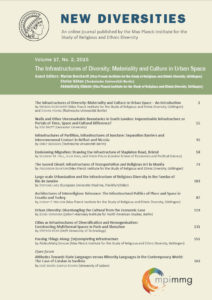Infrastructures of Partition, Infrastructures of Juncture: Separation Barriers and Intercommunal Contact in Belfast and Nicosia
by Emily Bereskin (Technische Universität Berlin)
To cite this article: Bereskin, E. (2015). Infrastructures of Partition, Infrastructures of Juncture: Separation Barriers and Intercommunal Contact in Belfast and Nicosia. New Diversities, 17(2), 35–58. https://doi.org/10.58002/h7af-7519
Through an analysis of Belfast, Northern Ireland and Nicosia, Cyprus, this article considers how separation barriers catalyze social mixing and cooperation in ethnonationally divided cities. Due to their highly visible and symbolic nature as well as their physical location at the interface between communities, I argue that the barrier is a critical infrastructural element whose management and symbolic interpretation can motivate intercommunal cooperation – just as it can incite conflict. This article analyzes four socio-material interventions designed to ameliorate spatial and social divide: 1) the regeneration or aestheticization of barriers; 2) the negotiation of border openings; 3) the use of the border as a catalyst for intergroup activities; and 4) the creation of shared spaces at the boundary line. I discuss the possibilities and limitations of these practices both as confidence-building measures and as activities that foster social mixing. The article concludes by querying if barrier projects may inadvertently funnel funding away from more localized, single-community peacebuilding activities.
Keywords: barrier, reconciliation, social mixing, Belfast, Nicosia
|
